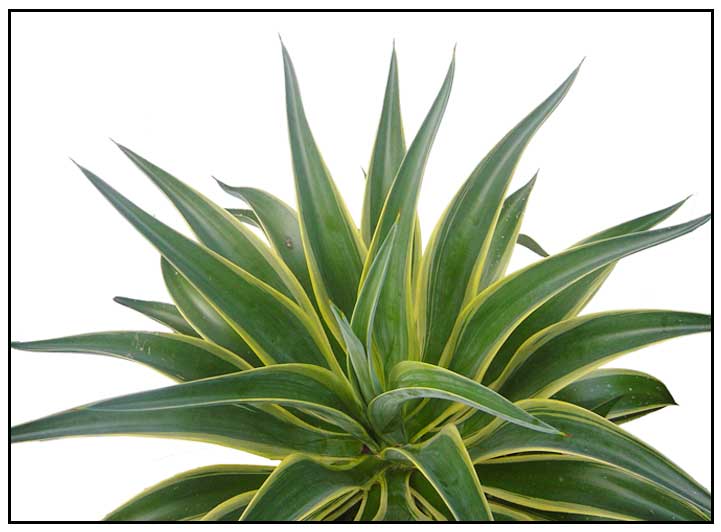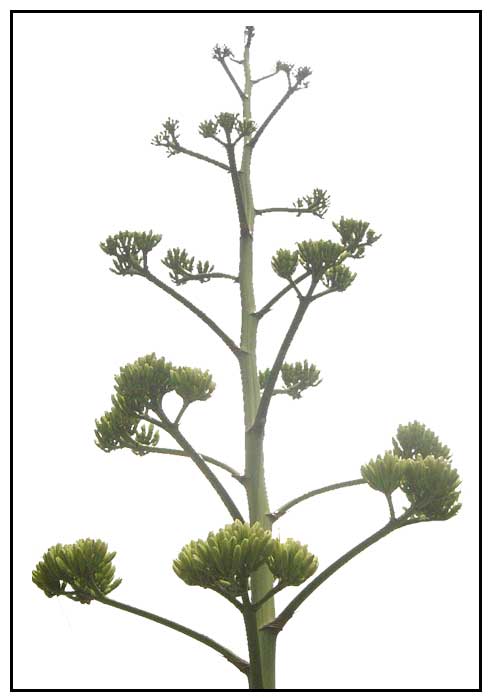 Botany Botany
Agave is a tropical plant with
about 300 species. The leaves are fibrous, growing upward from the ground
forming a massive rosette. Both sides of the leaves are smooth, with
prickly edges and a thorny tips. The plant produces a flower stalk in
about ten years, and dies after the fruit ripens. The pineapple-shaped heart of the plant yields a sweet sticky juice, agave nectar.
 Distribution Distribution
- In thickets at low and
medium altitudes.
Constituents
- Study isolated two new spirostanol glycosides: agamenoside A and B.
Study yielded a new steroidal saponin: a bisdesmosidic spirostanol saponin. (3)
- Studies on chemical composition of leaves yielded high amount of total dietary fiber (38.40%), total sugars (45.83%), and protein (35.33%), with a relatively low ash content (5.94%) and lipid (2.03%). Agave inulin showed significant differences when compared to commercial inulin. (8)
- Study of leaves isolated tigogenin, hecogenin, 9-dehydrohecogenin, rockogenin,12-epirockogenin, gitogenin, chlorogenin and manogenin. (10)
Properties
- Considered antiseptic,
depurative, diuretic and laxative.
- Studies suggest antibacterial, anti-inflammatory properties.
Parts utilized
- Leaves, sap.
Uses
Edibility
- The pineapple-shaped heart of the plant yields a sweet sticky juice, agave nectar, which can be made into a syrup and used as a sweetener, with a taste similar to honey.
Folkloric
- For cleansing the blood,
a cup daily of an infusion of two grams of finely chopped leaves in
each cup of water.
Infusion of the leaves used as disinfectant and tonic for falling hair.
- Sap of leaves used internally for wound healing and inflammations.
Infusion of the plant with honey to soothe irritation of the eyes.
- Decoction of leaves also used as wash for general eye problems.
- Powdered plant used for anemia, kidney diseases and liver problems.
Others
- Agave is best known for its role in tequila.
Studies
• Antibacterial: Study yielded tetratriacontanol, tetratriacontyl hexadecanoate and a new 2-tritriacontylchromone; two of them exhibited significant antibacterial activity. (1)
• Anti-Inflammatory: Study evaluated the anti-inflammatory
activity of aqueous extracts and steroidal sapogenins of Agave americana. Extracts showed good anti-inflammatory activity. (2)
• Hecogenin Tetraglycoside /Cytotoxic activity: A new steroidal
saponin from the leaves of Agave americana: Study isolated a new
bisdesmosidic spirostanol saponin along with three known saponins. Hecogenin
tetraglycoside showed cytotoxic activity against HL-60 human promyelocytic
leukemia cells.
• Cytotoxic activity: Study evaluated the cytotoxicity of various parts of medicinal plants such as Agave americana, Strychnos nuxvomica and Areca catechu using MCF-7 and Vero cell line. Results showed the methanol extract of Agave americana and aqueous extract of Areca catechu are potent cytotoxic. (6)
• Fructosyl Transferase: Study investigated the possible role of fructosyl transferase in the biosynthesis of fructosans in Agave americana. The possible mechanisms of fructosan biosynthesis from sucrose is discussed. (7)
• Anti-Anxiety / Leaves: Study evaluated the anti-anxiety effects of an ethanolic extract of Agave americana leaves in rat and mice. Results obtained from experimental models confirmed the anxiolytic activity (400mg/kg) comparable to standard drug diazepam. Activity was attributed to flavonoid phytoconstituents. (9)
• Anti-Leishmanial / Leaves: Study evaluated the comparative in vitro anti-leishmanial activity of various fractions of Agave americana extracts. An ethyl acetate fractions showed significant anti-leishmanial activity with IC50-25 µg/ml complete inhibition (IC50) at 50µg/ml. (11)
• Biosorbent: Study reports on the use of Agave americana fibers as a new low cost and abundant biosorbent to remove metal dye (Alpacide yellow) from aqueous solutions. Findings showed a spontaneous and endothermic biosorption process. (12)
• Agave Dermatitis: Study reports on a case of Agave-induced purpura in an otherwise healthy patient. Histopathology was consistent with an evolving leukocytoclastic vasculitis. (13) Study reports on 12 cases of self-inflicted contact dermatitis provoked by Agave americana, ten with systemic signs and symptoms, 8 with abnormal laboratory results. Treatment consisted of oral antihistamines and topical saline compresses. (14)
Caution
!
•
Contact
Dermatitis
- The sap of Agave americana contains calcium oxalate crystals, acrid
oils, saponins, among other compounds. Despite the known irritants,
dermatitis is only rarely reported. (see study above) (13)
- A report of 12 cases
of contact dermatitis secondary to intentional exposure in soldiers
seeking sick leave. (see study above) (14)
Availability
Wildcrafted.
|


 Botany
Botany Distribution
Distribution

